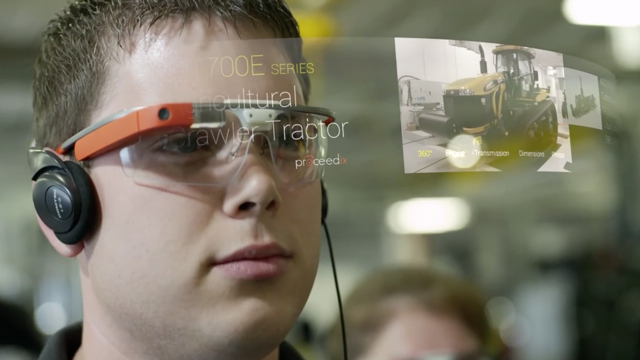Early Corporate Trials with Augmented Reality Prove its Value
December 14, 2016
Augmented reality has found a spot on the factory floor of AGCO Corp., a company that manufactures agricultural equipment in Jackson, Minnesota. Workers wear Google Glasses that display diagrams and instructions as an aid in conducting quality checks on tractors and chemical sprayers. The result is so successful that the Duluth, Georgia-based company plans to expand the program next year, using 3D computer-generated imagery to help workers weld 30-foot booms to chemical sprayers.
The Wall Street Journal reports that AGCO director of business-process improvement Peggy Gulick says QC is now “up to 20 percent faster” with the help of augmented-reality glasses.
Although augmented reality is still in its infancy with regard to commercial deployment, the technology is expected to become mainstream, according to MIT researchers who note that, “improvements in the performance of AR equipment, like the Microsoft HoloLens, and expected reductions in its cost” will make AR specifically useful in the supply chain.
To bring that day closer, MIT is building a multimillion-dollar, 500-square-foot Visual Analytics Lab at its Center for Transportation and Logistics. There, corporations and researchers will be able to experiment with “computer-generated hologram-like images and interactive touchscreen walls embedded with layers of supply-chain data that is often obscured,” including “customer and product information to population, socioeconomic data and real-time traffic, weather and social-media data.”
The lab, which will open in 2017 to corporations and MIT departments, is funded “in part by corporations with which MIT already has existing relationships.”
MIT researcher Matthias Winkenbach leads the project. “AR can be a game changer in data and analytics because it’s so much more immersive,” he said. “You’re … experiencing much more than you’re analyzing.”
Daqri co-founder/chief executive Brian Mullins, whose company makes an AR helmet with infrared, thermal and high-speed wide-angle cameras that allow users to see holograms outdoors in direct sunlight, notes that “holograms are particularly useful tools for visualizing data because they engage the spatial awareness part of the brain that allows humans to understand complex concepts more quickly and promotes greater retention.”
Other companies involved in early experimentation with AR include General Electric’s Oil & Gas turbo-machinery facility in Florence, Italy; and Boeing’s pilot program at the Electrical Strategic Fabrication Center in Mesa, Arizona.
Forrester Research predicts that “about 14.4 million U.S. workers will use ‘smart glasses,’ such as Google Glass and HoloLens in 2025, up from 400,000 this year,” and large companies will spend $3.6 billion on smart glasses in 2025, up from $6 million in 2016.


No Comments Yet
You can be the first to comment!
Sorry, comments for this entry are closed at this time.